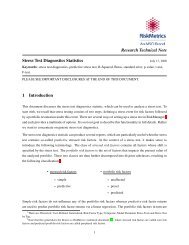Managing Synthetic CDO Tranches using Base Correlations
Managing Synthetic CDO Tranches using Base Correlations
Managing Synthetic CDO Tranches using Base Correlations
Create successful ePaper yourself
Turn your PDF publications into a flip-book with our unique Google optimized e-Paper software.
Gaussian Copula Model<br />
<br />
<br />
Standard Model Assumptions: One-factor Gaussian copula model<br />
F<br />
i<br />
( t)<br />
= Pr[ τ<br />
i<br />
< t]<br />
⇔ Φ(<br />
Zi<br />
) = F(<br />
ti<br />
)<br />
Conceptual two name example<br />
Z<br />
i<br />
= ρ Z + 1− ρε<br />
i<br />
2.5<br />
Correlated normals<br />
100<br />
Correlated default times<br />
2<br />
1.5<br />
1<br />
0.5<br />
t<br />
t<br />
1<br />
2<br />
=<br />
=<br />
F<br />
F<br />
−1<br />
1<br />
−1<br />
2<br />
( Φ(<br />
z<br />
( Φ(<br />
z<br />
1<br />
2<br />
))<br />
))<br />
90<br />
80<br />
70<br />
60<br />
0<br />
50<br />
-0.5<br />
40<br />
-1<br />
30<br />
-1.5<br />
20<br />
-2<br />
10<br />
-2.5<br />
-3 -2 -1 0 1 2 3<br />
0<br />
0 5 10 15 20 25 30 35 40 45 50<br />
9

















